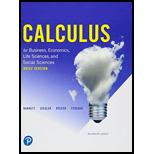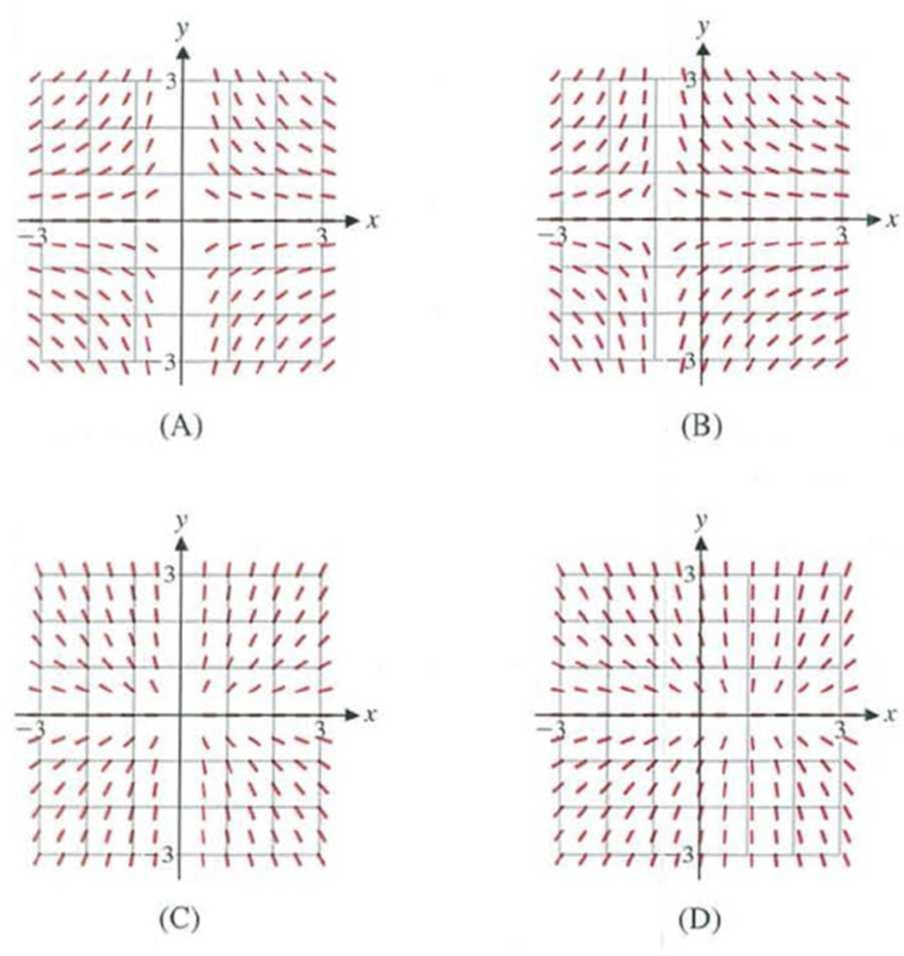
In Problems 25–28, use the appropriate slope field—(A), (B), (C), or (D), given for Problems 21–24 (or a copy)—to graph the particular solutions obtained by letting C = –2, –1, 0, 1, and 2.
26. y = C (x – 1)2 (From Problem 15)
15.
In Problems 21–24, determine which of the slope fields (A)–(D) is associated with the indicated differential equation. Briefly justify your answer.

Want to see the full answer?
Check out a sample textbook solution
Chapter 9 Solutions
EBK CALCULUS FOR BUSINESS, ECONOMICS, L
- 3) Compute where C is the circle |z― i| = - 1 2 2+1 Po z z - 2)2 dz traversed counterclockwise. Solution: TYPE YOUR SOLUTION HERE! INCLUDE A SKETCH OF THE COM- PLEX PLANE AND THE CURVE C. ALSO, MARK ALL SINGULARITIES OF THE INTEGRAND!arrow_forward2) Consider the function f (z = re²) = e cos(In(r)) + ie¯* sin(ln(r)). Show that is holomorphic at all points except the origin. Also show that =arrow_forward3) If a is a positive number, what is the value of the following double integral? 2a Love Lv 2ay-y² .x2 + y2 dadyarrow_forward
- 2) Consider the set SL(n, R) consisting of n x n matrices with real entries having de- terminant equal to 1. Prove that SL(n, R) is a group under the operation of matrix multiplication (it is referred to as the Special Linear Group).arrow_forward1) What is the parity of the following permutation? (1389) (24) (567)arrow_forward4.7 Use forward and backward difference approximations of O(h) and a centered difference approximation of O(h²) to estimate the first derivative of the function examined in Prob. 4.5. Evaluate the derivative at x = 2 using a step size of h = 0.2. Compare your results with the true value of the derivative. Interpret your results on the basis of the remainder term of the Taylor series expansion.arrow_forward
- Write 3/5 as a percentagearrow_forward16. Solve each of the following equations for x. (a) 42x+1 = 64 (b) 27-3815 (c) 92. 27² = 3-1 (d) log x + log(x - 21) = 2 (e) 3 = 14 (f) 2x+1 = 51-2xarrow_forward4.5 Use zero- through third-order Taylor series expansions to predict f(2.5) for f(x) = 25x³- 6x²+7x - 88 using a base point at x = 1. Compute the true percent relative error ε, for each approximation.arrow_forward
 Discrete Mathematics and Its Applications ( 8th I...MathISBN:9781259676512Author:Kenneth H RosenPublisher:McGraw-Hill Education
Discrete Mathematics and Its Applications ( 8th I...MathISBN:9781259676512Author:Kenneth H RosenPublisher:McGraw-Hill Education Mathematics for Elementary Teachers with Activiti...MathISBN:9780134392790Author:Beckmann, SybillaPublisher:PEARSON
Mathematics for Elementary Teachers with Activiti...MathISBN:9780134392790Author:Beckmann, SybillaPublisher:PEARSON
 Thinking Mathematically (7th Edition)MathISBN:9780134683713Author:Robert F. BlitzerPublisher:PEARSON
Thinking Mathematically (7th Edition)MathISBN:9780134683713Author:Robert F. BlitzerPublisher:PEARSON Discrete Mathematics With ApplicationsMathISBN:9781337694193Author:EPP, Susanna S.Publisher:Cengage Learning,
Discrete Mathematics With ApplicationsMathISBN:9781337694193Author:EPP, Susanna S.Publisher:Cengage Learning, Pathways To Math Literacy (looseleaf)MathISBN:9781259985607Author:David Sobecki Professor, Brian A. MercerPublisher:McGraw-Hill Education
Pathways To Math Literacy (looseleaf)MathISBN:9781259985607Author:David Sobecki Professor, Brian A. MercerPublisher:McGraw-Hill Education





